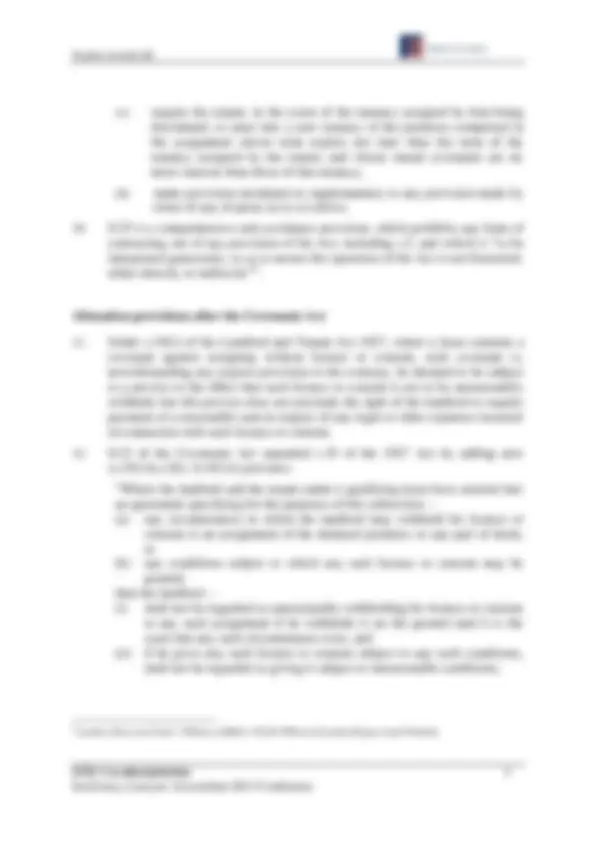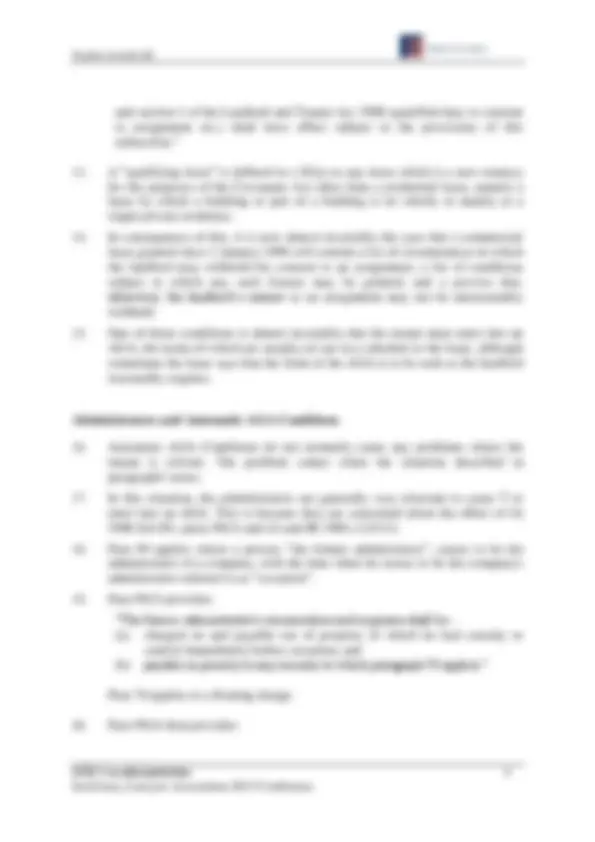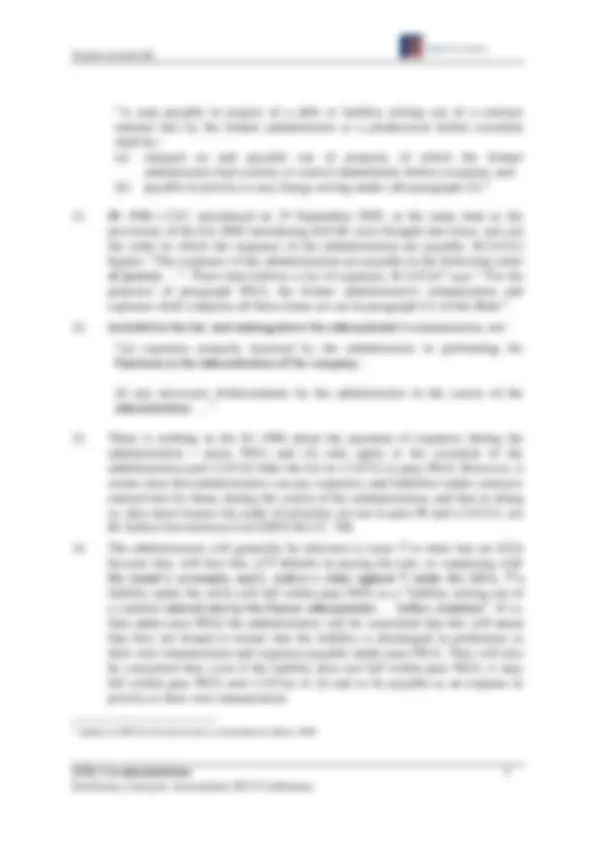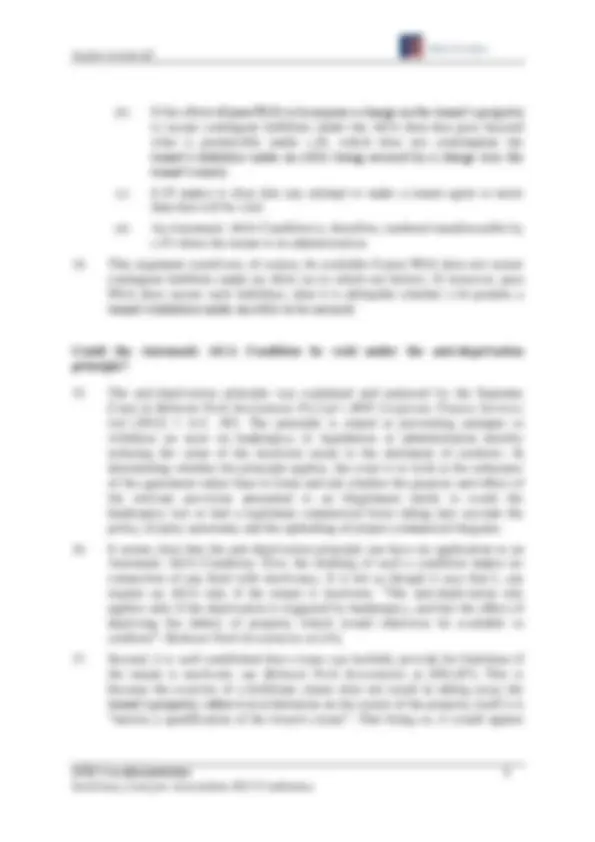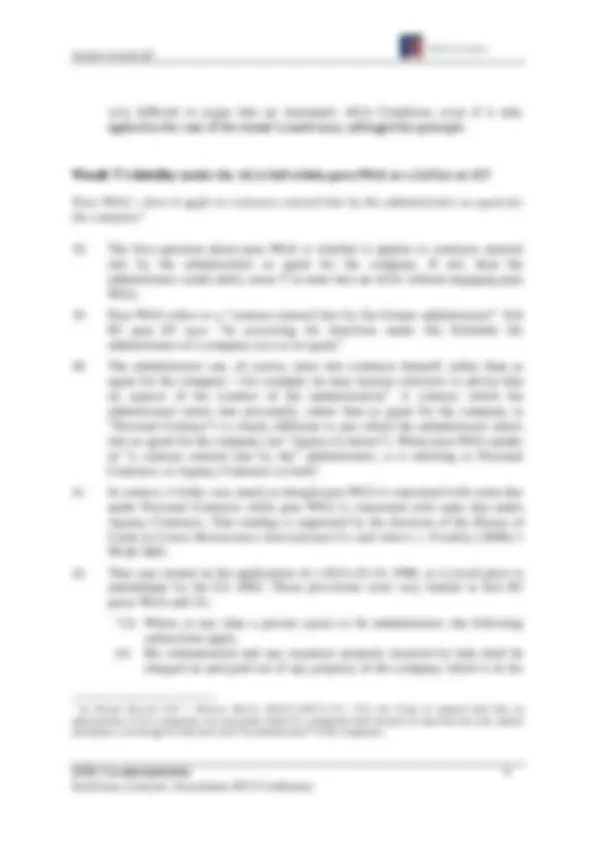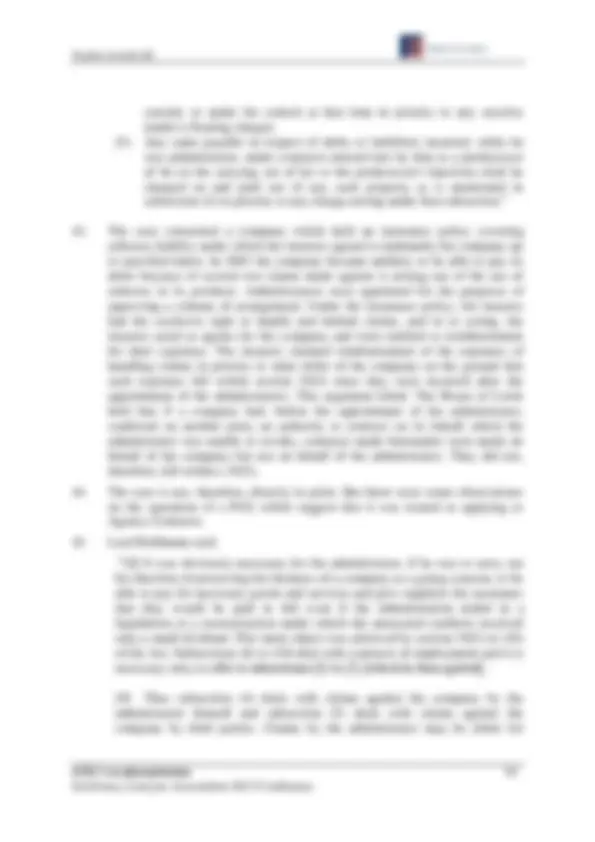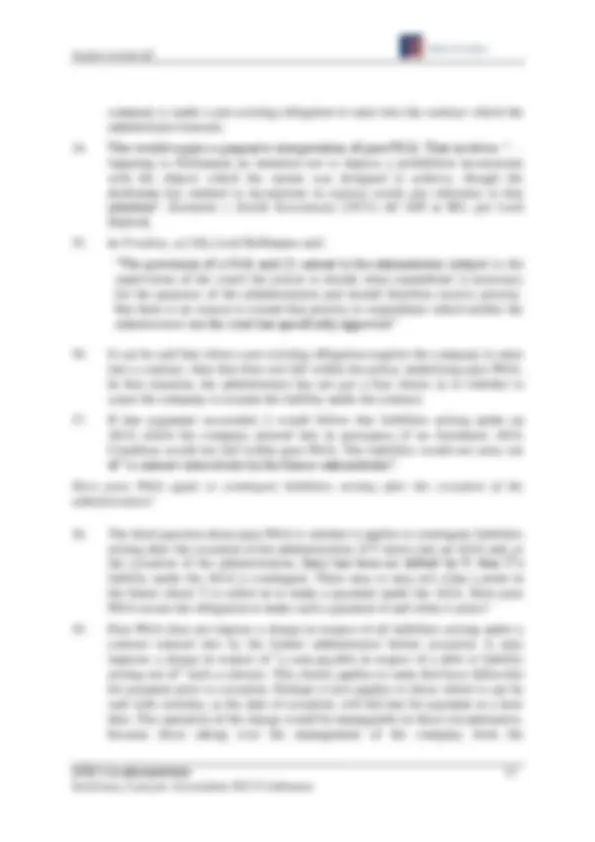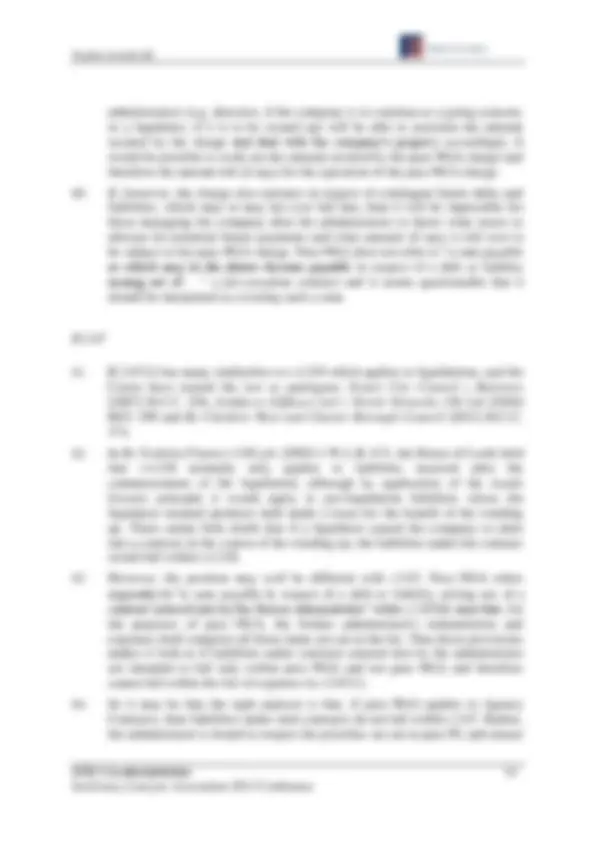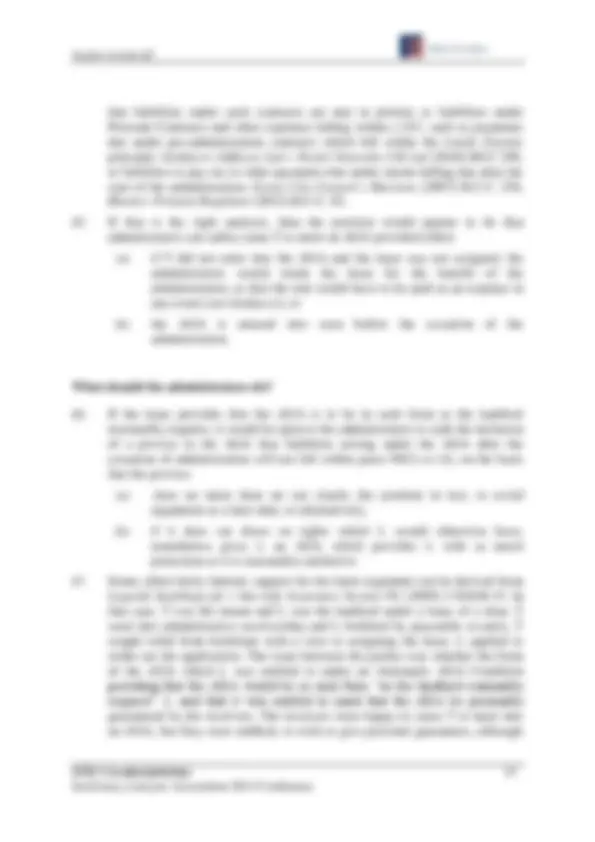Download AGAs in Insolvency Administration: Liabilities and Priorities and more Study notes Law in PDF only on Docsity!
AGA’s in administration 1
AGAs in administration
A paper for the Insolvency Lawyers’ Association 2013 Conference
Introduction
- This paper considers the situation where a company, T, is the tenant under a commercial lease. The administrators of T wish to assign the lease to a purchaser of T’s business and assets, P. The lease includes a covenant by the tenant not to assign without the licence of the landlord, L, not to be unreasonably withheld. It also contains a clause (an “Automatic AGA Condition”) stating that L may require, as a condition of granting licence to assign, that T enters into an authorised guarantee agreement (“AGA”), guaranteeing the obligations of the assignee. The administrators have sought L’s licence to assign to P, and L has said it will require an AGA as a condition of granting licence. Can L require an AGA in this situation? And, if so, will liabilities under the AGA be given “super-priority” under IA 1986 para 99 and IR 1986 r.2.67 above other liabilities, including the payment of the administrators’ remuneration?
The Covenants Act
- Until the Landlord and Tenant (Covenants) Act 1995, the law was that the original tenant under a lease remained liable to pay the rent and observe and perform the tenant’s covenants in the lease for the whole of the term. Since many commercial leases were granted for terms of 25 years, this could be very onerous. In 1988, the Law Commission recommended the reform of the law in this area^1. “The mischief at which the Commission's recommendations were aimed was the continuation of a liability long after the parties had parted with their interests in the property to which it related”^2.
- Many of the provisions of the Covenants Act only apply to “new tenancies”, essentially those entered into into on or after 1 January 1996: see section 1(3)^3. Inevitably, with the passage of time since 1995, more and more leases encountered in practice are “new tenancies”.
(^1) Landlord and Tenant Law: Privity of Contract and Estate (1988) (Law Com No 174) (^2) London Diocesan Fund v Phithwa [2005] 1 WLR 3956 at [39] per Baroness Hale. (^3) In certain limited circumstances, a lease will not be a “new tenancy” even if entered into on or after 1 January 1996 e.g. if entered into in pursuance of an agreement or option entered into before that date, or an order of a court made before that date.
AGA’s in administration 2
- In the case of new tenancies, when there is an assignment of the tenancy, the tenant is released from all liability from the date of the assignment: s.5. This does not apply, however, if the assignment is one in breach of a covenant of a tenancy, or is an assignment by operation of law: s.11.
- S.16 provides for a limited exception to the general rule that a tenant is released on a lawful assignment of the lease. It provides that, where on an assignment a tenant is to any extent released from a tenant covenant of a tenancy by virtue of the Act, nothing in the Act shall preclude him from entering into an AGA with respect to the performance of that covenant by the assignee.
- S.16(2) provides that an agreement is an AGA if under it the tenant guarantees the performance of the relevant covenant to any extent by the assignee, it is entered into in the circumstances set out in 16(3) and its provisions conform with subsections (4) and (5).
- S.16(3) provides that the circumstances in which an AGA may be entered into are as follows: “(a) by virtue of a covenant against assignment (whether absolute or qualified) the assignment cannot be effected without the consent of the landlord under the tenancy or some other person; (b) any such consent is given subject to a condition (lawfully imposed) that the tenant is to enter into an agreement guaranteeing the performance of the covenant by the assignee; and (c) the agreement is entered into by the tenant in pursuance of that condition.”
- S.16(4) provides that an agreement is not an AGA to the extent that it purports to impose on the tenant any requirement to guarantee in any way the performance of the relevant covenant by any person other than the assignee; or to impose on the tenant any liability, restriction or other requirement (of whatever nature) in relation to any time after the assignee is released from that covenant by virtue of the Act.
- S.16(5) provides that an AGA may:
(a) impose on the tenant any liability as sole or principal debtor in respect of any obligation owed by the assignee under the relevant covenant; (b) impose on the tenant liabilities as guarantor in respect of the assignee’s performance of that covenant which are no more onerous than those to which he would be subject in the event of his being liable as sole or principal debtor in respect of any obligation owed by the assignee under that covenant;
AGA’s in administration 4
and section 1 of the Landlord and Tenant Act 1988 (qualified duty to consent to assignment etc.) shall have effect subject to the provisions of this subsection.”
- A “qualifying lease” is defined in s.1E(a) as any lease which is a new tenancy for the purposes of the Covenants Act other than a residential lease, namely a lease by which a building or part of a building is let wholly or mainly as a single private residence.
- In consequence of this, it is now almost invariably the case that a commercial lease granted since 1 January 1996 will contain a list of circumstances in which the landlord may withhold his consent to an assignment, a list of conditions subject to which any such licence may be granted, and a proviso that, otherwise, the landlord’s consent to an assignment may not be unreasonably withheld.
- One of those conditions is almost invariably that the tenant must enter into an AGA, the terms of which are usually set out in a schedule to the lease, although sometimes the lease says that the form of the AGA is to be such as the landlord reasonably requires.
Administrators and Automatic AGA Conditions
- Automatic AGA Conditions do not normally cause any problems where the tenant is solvent. The problem comes when the situation described in paragraph1 arises.
- In this situation, the administrators are generally very reluctant to cause T to enter into an AGA. This is because they are concerned about the effect of IA 1986 Sch B1, paras 99(3) and (4) and IR 1986 r.2.67(1).
- Para 99 applies where a person, “the former administrator”, ceases to be the administrator of a company, with the time when he ceases to be the company's administrator referred to as “cessation”.
- Para 99(3) provides:
“The former administrator's remuneration and expenses shall be-- (a) charged on and payable out of property of which he had custody or control immediately before cessation, and (b) payable in priority to any security to which paragraph 70 applies.”
Para 70 applies to a floating charge.
- Para 99(4) then provides:
AGA’s in administration 5
“A sum payable in respect of a debt or liability arising out of a contract entered into by the former administrator or a predecessor before cessation shall be-- (a) charged on and payable out of property of which the former administrator had custody or control immediately before cessation, and (b) payable in priority to any charge arising under sub-paragraph (3).”
- IR 1986 r.2.67, introduced on 15 September 2003, at the same time as the provisions of the EA 2002 introducing Sch B1 were brought into force, sets out the order in which the expenses of the administration are payable. R.2.67(1) begins: “The expenses of the administration are payable in the following order of priority …”. There then follows a list of expenses. R.2.67(4)^5 says “ For the purposes of paragraph 99(3), the former administrator's remuneration and expenses shall comprise all those items set out in paragraph (1) of this Rule”.
- Included in the list, and ranking above the administrator’s remuneration, are:
“(a) expenses properly incurred by the administrator in performing his functions in the administration of the company …
(f) any necessary disbursements by the administrator in the course of the administration ….”
- There is nothing in the IA 1986 about the payment of expenses during the administration – paras 99(3) and (4) only apply at the cessation of the administration and r.2.67(4) links the list in r.2.67(1) to para 99(3). However, it seems clear that administrators can pay expenses, and liabilities under contracts entered into by them, during the course of the administration, and that in doing so, they must respect the order of priorities set out in para 99 and r.2.67(1): see Re Salmet International Ltd [2001] B.C.C. 796.
- The administrators will generally be reluctant to cause T to enter into an AGA because they will fear that, if P defaults in paying the rent, or complying with the tenant’s covenants, and L makes a claim against T under the AGA, T’s liability under the AGA will fall within para 99(4) as a “liability arising out of a contract entered into by the former administrator … before cessation”. If so, then under para 99(4) the administrators will be concerned that this will mean that they are bound to ensure that the liability is discharged in preference to their own remuneration and expenses payable under para 99(3). They will also be concerned that, even if the liability does not fall within para 99(4), it may fall within para 99(3) and r.2.67(a) or (f) and so be payable as an expense in priority to their own remuneration.
(^5) Added in 2005 by the Insolvency (Amendment) Rules 2005
AGA’s in administration 7
liabilities of the assignee. The Court held that that such a contract would frustrate s.24 of the Covenants Act, which provides for the release of a guarantor when a tenant is released. The Court then entered into a lengthy, obiter, discussion on how the Covenants Act applies in various circumstances, which discussion included the passage quoted above. This discussion, and the conclusions it reached, are controversial^6 and this paper is not the place to discuss the criticisms of it.
- In relation to the passage set out above, the Court of Appeal did not spell out what it had in mind when suggesting that s.16(3)) may preclude a landlord relying on an Automatic AGA Condition.
- S.19(1A) of the 1927 Act, quoted above, which was introduced by the 1995 Act, provides that a landlord and tenant under a commercial lease may agree in advance a condition which the landlord may impose on the grant of a licence to assign, and that if he gives any such licence subject to any such condition, he shall not be regarded as giving it subject to an unreasonable condition.
- So, in general, if the landlord and tenant agree in the lease that the landlord may require an AGA as a condition of granting licence to assign, and then, when the tenant seeks licence to assign, the landlord grants it on condition that an AGA is entered into, it may be difficult to argue that it is not a condition which is “lawfully imposed”.
- It may also be difficult to argue that the condition is not “lawfully imposed” because of the landlord’s motives for seeking to impose it. The landlord may, for example, be motivated by a desire to prevent the assignment from proceeding in order to secure the surrender or forfeiture of the lease in order to let the property to a tenant who the landlord prefers to P, or to redevelop the property, or he may be motivated by the belief that, if the AGA is entered into, it will give him valuable rights under para 99(4) and/or r.2.67. None of those matters would appear relevant to the question of whether the condition is one “lawfully imposed”, given that the right to impose the condition is set out in the lease, with the authority of s.19(1A) of the 1927 Act.
- It may, however, be arguable that requiring an AGA from a company in administration does infringe s.25 of the Covenants Act. The argument is as follows: (a) The limits of what a tenant may agree to by way of an AGA are set out in s.16.
(^6) See e.g. Tenants, Guarantors and AGAs - Where Now?, a paper delivered by Jonathan Small QC and Zia Bhaloo QC at the 37th^ Blundell Memorial Lectures on 2 July 2012 which contains an extensive critical analysis of the obiter discussion and conclusions in K/S Victoria.
AGA’s in administration 8
(b) If the effect of para 99(4) is to impose a charge on the tenant’s property to secure contingent liabilities under the AGA then that goes beyond what is permissible under s.16, which does not contemplate the tenant’s liabilities under an AGA being secured by a charge over the tenant’s assets. (c) S.25 makes it clear that any attempt to make a tenant agree to more than that will be void. (d) An Automatic AGA Condition is, therefore, rendered unenforceable by s.25 where the tenant is in administration.
- That argument would not, of course, be available if para 99(4) does not secure contingent liabilities under an AGA (as to which see below). If, however, para 99(4) does secure such liabilities, then it is debatable whether s.16 permits a tenant’s liabilities under an AGA to be secured.
Could the Automatic AGA Condition be void under the anti-deprivation principle?
- The anti-deprivation principle was explained and analysed by the Supreme Court in Belmont Park Investments Pty Ltd v BNY Corporate Trustee Services Ltd [2012] 1 A.C. 383. The principle is aimed at preventing attempts to withdraw an asset on bankruptcy or liquidation or administration thereby reducing the value of the insolvent estate to the detriment of creditors. In determining whether the principle applies, the court is to look at the substance of the agreement rather than its form and ask whether the purpose and effect of the relevant provision amounted to an illegitimate intent to evade the bankruptcy law or had a legitimate commercial basis taking into account the policy of party autonomy and the upholding of proper commercial bargains.
- It seems clear that the anti-deprivation principle can have no application to an Automatic AGA Condition. First, the drafting of such a condition makes no connection of any kind with insolvency. It is not as though it says that L can require an AGA only if the tenant is insolvent. “The anti-deprivation rule applies only if the deprivation is triggered by bankruptcy, and has the effect of depriving the debtor of property which would otherwise be available to creditors”: Belmont Park Investments at [14].
- Second, it is well established that a lease can lawfully provide for forfeiture if the tenant is insolvent: see Belmont Park Investments at [85]-[87]. This is because the exercise of a forfeiture clause does not result in taking away the tenant’s property; rather it is a limitation on the extent of the property itself it is “merely a qualification of the lessee's estate”. That being so, it would appear
AGA’s in administration 10
custody or under his control at that time in priority to any security [under a floating charge]. (5) Any sums payable in respect of debts or liabilities incurred, while he was administrator, under contracts entered into by him or a predecessor of his in the carrying out of his or the predecessor's functions shall be charged on and paid out of any such property as is mentioned in subsection (4) in priority to any charge arising under that subsection.”
- The case concerned a company which held an insurance policy covering asbestos liability under which the insurers agreed to indemnify the company up to specified limits. In 2001 the company became unlikely to be able to pay its debts because of several tort claims made against it arising out of the use of asbestos in its products. Administrators were appointed for the purposes of approving a scheme of arrangement. Under the insurance policy, the insurers had the exclusive right to handle and defend claims, and in so acting, the insurers acted as agents for the company and were entitled to reimbursement for their expenses. The insurers claimed reimbursement of the expenses of handling claims in priority to other debts of the company on the ground that such expenses fell within section 19(5) since they were incurred after the appointment of the administrators. This argument failed. The House of Lords held that if a company had, before the appointment of the administrator, conferred on another party an authority to contract on its behalf which the administrator was unable to revoke, contracts made thereunder were made on behalf of the company but not on behalf of the administrator. They did not, therefore, fall within s.19(5).
- The case is not, therefore, directly in point. But there were some observations on the operation of s.19(5) which suggest that it was treated as applying to Agency Contracts.
- Lord Hoffmann said:
“[8] It was obviously necessary for the administrator, if he was to carry out his function of preserving the business of a company as a going concern, to be able to pay for necessary goods and services and give suppliers the assurance that they would be paid in full even if the administration ended in a liquidation or a reconstruction under which the unsecured creditors received only a small dividend. This latter object was achieved by section 19(3) to (10) of the Act. Subsections (6) to (10) deal with contracts of employment and it is necessary only to refer to subsections (3) to (5) [which he then quoted]…
[9] Thus subsection (4) deals with claims against the company by the administrator himself and subsection (5) deals with claims against the company by third parties. Claims by the administrator may be either for
AGA’s in administration 11
remuneration or for expenses, that is to say, for goods and services supplied to the company for which the administrator has paid or chosen to make himself liable but for which he has not yet reimbursed himself out of the company's assets. Subsection (5) deals with debts and liabilities incurred by the administrator which have not been discharged and which were incurred under contracts entered into by the administrator “in the carrying out of his functions”. But the supplier will have the benefit of s.14(6), which provides that a person dealing with the administrator in good faith and for value ‘is not concerned to inquire whether the administrator is acting within his powers.
[10] The administrator's remuneration and expenses under subs.(4) have priority over a floating charge and of course over unsecured creditors if there is a liquidation. The outside creditors' debts under subs.(5) have ‘super- priority’ over the administrator as well.”
- Although he did not say so in terms, the tenor of his speech indicates that he thought that s.19(5) was concerned with Agency Contracts. In para [9] he said: that s.19(5) “deals with claims against the company by third parties”. That indicates that he had Agency Contracts in mind. With a Personal Contract, a third party’s claim would be against the administrator, not the company. The discussion later in his speech, in paras [15] and [16, also appears to be based on the assumption that if the administrator does cause the company to enter into a contract, the liabilities under that contract would fall within s.19(5).
- In Exeter City Council v Bairstow [2007] B.C.C. 236, David Richards J reviewed the decision in Freakley and summarised it as follows: “[26] The effect of s.19(4) and (5) was therefore that unless the administrator had decided to incur the expenditure in question, either by undertaking it personally or by making a contract on behalf of the company, a liability incurred by the company during the administration would not rank for priority under s.19(4) or super-priority under s.19(5)”.
Thus he seems to have thought that Freakley had proceeded on the basis that s.19(5) covered both Agency and Personal Contracts.
- There is one decision that appears to point the other way - Amble Assets LLP v Longbenton Foods Ltd [2011] EWHC 3774 (Ch). In that case, two companies in administration owned a lease and equipment. They entered into a contract to sell them to Longbenton. Under the contract, Longbenton made a payment a total of £1.44m by way of deposits on account of the completion price. Longbenton failed to complete and the sellers terminated the agreement. Longbenton then sought return of the deposits on the basis that they were
AGA’s in administration 13
company is under a pre-existing obligation to enter into the contract which the administrator honours.
- This would require a purposive interpretation of para 99(4). That involves: “… imputing to Parliament an intention not to impose a prohibition inconsistent with the objects which the statute was designed to achieve, though the draftsman has omitted to incorporate in express words any reference to that intention”: Kammins v Zenith Investments [1971] AC 850 at 881, per Lord Diplock.
- In Freakley, at [16], Lord Hoffmann said:
“The provisions of s.19(4) and (5) entrust to the administrator (subject to the supervision of the court) the power to decide what expenditure is necessary for the purposes of the administration and should therefore receive priority. But there is no reason to extend that priority to expenditure which neither the administrator nor the court has specifically approved.”
- It can be said that where a pre-existing obligation requires the company to enter into a contract, then that does not fall within the policy underlying para 99(4). In that situation, the administrator has not got a free choice as to whether to cause the company to assume the liability under the contract.
- If that argument succeeded, it would follow that liabilities arising under an AGA which the company entered into in pursuance of an Automatic AGA Condition would not fall within para 99(4). The liabilities would not arise out of “a contract entered into by the former administrator”.
Does para 99(4) apply to contingent liabilities arising after the cessation of the administration?
- The third question about para 99(4) is whether it applies to contingent liabilities arising after the cessation of the administration. If T enters into an AGA and, at the cessation of the administration, there has been no default by P, then T’s liability under the AGA is contingent. There may or may not come a point in the future where T is called on to make a payment under the AGA. Does para 99(4) secure the obligation to make such a payment if and when it arises?
- Para 99(4) does not impose a charge in respect of all liabilities arising under a contract entered into by the former administrator before cessation. It only imposes a charge in respect of “a sum payable in respect of a debt or liability arising out of” such a contract. This clearly applies to sums that have fallen due for payment prior to cessation. Perhaps it also applies to those which it can be said with certainty, at the date of cessation, will fall due for payment at a later date. The operation of the charge would be manageable in those circumstances, because those taking over the management of the company from the
AGA’s in administration 14
administrators (e.g. directors, if the company is to continue as a going concern, or a liquidator, if it is to be wound up) will be able to ascertain the amount secured by the charge and deal with the company’s property accordingly. It would be possible to work out the amount secured by the para 99(4) charge and therefore the amount left (if any) for the operation of the para 99(3) charge.
- If, however, the charge also operates in respect of contingent future debts and liabilities, which may or may not ever fall due, then it will be impossible for those managing the company after the administrators to know what assets to allocate for potential future payments and what amount (if any) is left over to be subject to the para 99(3) charge. Para 99(4) does not refer to “a sum payable or which may in the future become payable in respect of a debt or liability arising out of… “ a pre-cessation contract and it seems questionable that it should be interpreted as covering such a sum.
R.2.
- R.2.67(1) has many similarities to r.4.218 which applies to liquidations, and the Courts have treated the two as analogous: Exeter City Council v Bairstow [2007] B.C.C. 236, Goldacre (Offices) Ltd v Nortel Networks UK Ltd [2010] BCC 299 and Re Cheshire West and Chester Borough Council [2011] B.C.C.
- In Re Toshoku Finance (UK) plc [2002] 1 W.L.R. 671, the House of Lords held that r.4.218 normally only applies to liabilities incurred after the commencement of the liquidation, although by application of the Lundy Granite principle it would apply to pre-liquidation liabilities where the liquidator retained premises held under a lease for the benefit of the winding up. There seems little doubt that if a liquidator caused the company to enter into a contract in the course of the winding up, the liabilities under the contract would fall within r.4.218.
- However, the position may well be different with r.2.67. Para 99(4) refers expressly to “a sum payable in respect of a debt or liability arising out of a contract entered into by the former administrator” while r.2.67(4) says that, for the purposes of para 99(3), the former administrator's remuneration and expenses shall comprise all those items set out in the list. Thus those provisions makes it look as if liabilities under contracts entered into by the administrator are intended to fall only within para 99(4) and not para 99(3) and therefore cannot fall within the list of expenses in r.2.67(1).
- So it may be that the right analysis is that, if para 99(4) applies to Agency Contracts, then liabilities under such contracts do not fall within r.2.67. Rather, the administrator is bound to respect the priorities set out in para 99, and ensure
AGA’s in administration 16
they had not yet determined one way or another whether to do so. L said that it was entitled to insist on an AGA which imposed personal liability on the receivers and since they had not said they were willing to enter into such an AGA, the assignment could not proceed and the application for relief was hopeless and should be struck out.
- L’s argument turned on s.44 IA 1986. L argued that if T entered into an AGA, the receivers would be personally liable under s.44(1)(b) and could not exclude such personal liability. Therefore L was under no obligation to accept an AGA which excluded the receivers’ liability. It could not be unreasonable to reject an AGA with a exclusion that s. 44 does not oblige the landlord to accept and that would render the guarantee valueless. That being so, there were no real prospects of T obtaining relief from forfeiture at the trial and its claim should be struck out.
- Laddie J rejected this argument. He said, at [15]-[16]:
“[15] … The AGA, without personal guarantee from the administrative receiver, is still an AGA within the meaning of section 16 of the 1995 Act. It therefore falls within both the definition in clause 4.7.1.2 of the lease and meets the requirements of clause 4.9.1. The only objection that can be taken to it is that it is not in “such form as the Landlord reasonably requires”. Whether the appellant's insistence upon the provision of personal guarantees can be considered reasonable is a question of fact to be decided by the trial judge… It is not an issue that, in normal circumstances, lends itself to resolution on a strike–out application.
[16] Here, Mr Wonnacott argued that it is inconceivable that the trial judge would hold that it was unreasonable for the appellant to insist upon those personal guarantees to which section 44 of the the 1986 Act entitles it. Although it may well be that the trial judge will say that the appellant is behaving reasonably in insisting on the personal guarantees, it is not inevitably so. It seems to me that the trial judge might conclude that, in the context of the lease, those considerations that the appellant can take into account in determining whether the form of the AGA is one that it reasonably requires do not include the possibility of requiring a third party, namely the administrative receiver, to offer personal guarantees. The lease requires guarantees from the outgoing tenant and also on behalf of the incoming new tenant. It does not require any guarantees from the administrative receiver or any other third party. It is, at least, possible that the trial judge would consider that the appellant's rejection of the AGA was not reasonable. In the circumstances, this is not a case in which it would be appropriate to strike out the respondent's claim for relief from forfeiture”.
AGA’s in administration 17
- Laddie J did not, then, discuss s.44. He did not comment on the argument that s.44 automatically makes receivers liable on any contract they cause the company to enter into. He regarded the question simply as one of reasonableness – whether the landlord reasonably could require the AGA to be in a form which imposed personal liability on the receivers. He appears to have considered that, if it was unreasonable to require the receivers to personally guarantee the AGA, then even if the effect of s.44 would otherwise have been to make the receivers liable, it was appropriate for the licence to exclude that liability.
- If the lease provides for the AGA to be in a form set out in a schedule to the lease, then it is not open to the administrators to contend that the AGA should be in a form which expressly provides that liabilities under the AGA do not fall within paras 99(3) or (4).
- However, it would be open to the administrators to seek the landlord’s agreement that liabilities arising under the AGA after the cessation of administration will not fall within paras 99(3) or (4). If such an agreement was made, it would probably be effective: see Amble Assets LLP v Longbenton Foods Ltd [2011] EWHC 3774 (Ch), referred to in para 48 above.
- If the landlord failed to agree to that, the administrators could apply to the Court for a declaration to that effect. The Court has a very wide power to make declarations where there is a real dispute about what the rights of parties will be in a given situation: see Gouriet v. Union of Post Office Workers [1978] A.C. 435, at 501, where Lord Diplock said that it is when “… there is a dispute between parties as to what their respective rights will be if something happens in the future, that the jurisdiction to make declarations of right can be most usefully invoked”. Since then, the circumstances in which the Court is prepared to grant declaratory relief are considerably wider than they were thought to be at the time of Gouriet : see Rolls-Royce v Unite [2010] 1 WLR 318 at [118]- [120] and for a recent example of declarations being made to avoid the possibility of future disputes, see Pavledes v Hadjisavva [2013] EWHC 124 (Ch).

